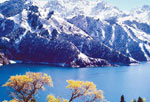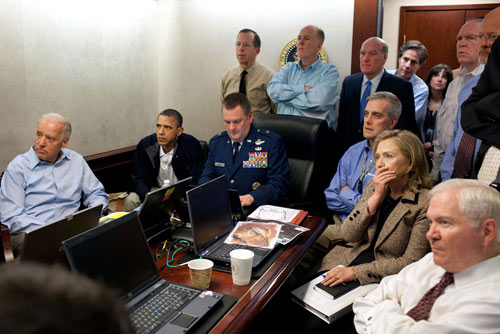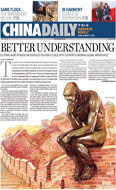Politics
One unwary call led US to bin Laden doorstep
Updated: 2011-05-03 09:51
(Agencies)
|
|
WASHINGTON - When one of Osama bin Laden's most trusted aides picked up the phone last year, he unknowingly led US pursuers to the doorstep of his boss, the world's most wanted terrorist.
That phone call, recounted Monday by US official, ended a years-long search for bin Laden's personal courier, the key break in a worldwide manhunt. The courier, in turn, led US intelligence to a walled compound in northeast Pakistan, where a team of Navy SEALS shot bin Laden to death.
In a secret CIA prison in Eastern Europe years ago, al-Qaida's No 3 leader, Khalid Sheikh Mohammed, gave authorities the nicknames of several of bin Laden's couriers, four former US intelligence officials said. Those names were among thousands of leads the CIA was pursuing.
One man became a particular interest for the agency when another detainee, Abu Faraj al-Libi, told interrogators that when he was promoted to succeed Mohammed as al-Qaida's operational leader he received the word through a courier. Only bin Laden would have given al-Libi that promotion, CIA officials believed.
If they could find that courier, they could find bin Laden.
The revelation that intelligence gleaned from the CIA's so-called black sites helped kill bin Laden was seen as vindication for many intelligence officials who have been repeatedly investigated and criticized for their involvement in a program that involved the harshest interrogation methods in US history.
"We got beat up for it, but those efforts led to this great day," said Marty Martin, a retired CIA officer who for years led the hunt for bin Laden.
It took years of work for intelligence agencies to identify the courier's real name, which officials are not disclosing. When they did identify him, he was nowhere to be found. The CIA's sources didn't know where he was hiding. Bin Laden was famously insistent that no phones or computers be used near him, so the eavesdroppers at the National Security Agency kept coming up cold.
Then in the middle of last year, the courier had a telephone conversation with someone who was being monitored by US intelligence, according to an American official, who like others interviewed for this story spoke only on condition of anonymity to discuss the sensitive operation. The courier was located somewhere away from bin Laden's hideout when he had the discussion, but it was enough to help intelligence officials locate and watch him.
In August 2010, the courier unknowingly led authorities to a compound in the northeast Pakistani town of Abbottabad. The walls surrounding the property were as high as 18 feet (6 meters) and topped with barbed wire. No telephone or Internet lines ran from the compound. It had all the hallmarks of a hideout built especially for bin Laden. But since bin Laden never traveled and nobody could get onto the compound without passing through two security gates, there was no way to be sure.
Despite that uncertainty, intelligence officials realized this could represent the best chance ever to get to bin Laden. They decided not to share the information with anyone, including staunch counterterrorism allies such as Britain, Canada and Australia.
By mid-February, the officials were convinced a "high-value target" was hiding in the compound. President Barack Obama wanted to take action.
"They were confident and their confidence was growing: 'This is different. This intelligence case is different. What we see in this compound is different than anything we've ever seen before,"' John Brennan, the president's top counterterrorism adviser, said Monday. "I was confident that we had the basis to take action."
Options were limited. The compound was in a residential neighborhood in a sovereign country. If Obama ordered an airstrike and bin Laden was not in the compound, it would be a huge diplomatic problem. Even if Obama was right, obliterating the compound might make it nearly impossible to confirm bin Laden's death.
Said Brennan: "The president had to evaluate the strength of that information, and then made what I believe was one of the most gutsiest calls of any president in recent memory."
Obama tapped two dozen members of the Navy's elite SEAL Team Six to carry out a raid with surgical accuracy.
Before dawn Monday morning, a pair of helicopters left Jalalabad in eastern Afghanistan. The choppers entered Pakistani airspace using sophisticated technology intended to evade that country's radar systems, a US official said.
Officially, it was a kill-or-capture mission, since the US does not kill unarmed people trying to surrender. But it was clear from the beginning that whoever was behind those walls had no intention of surrendering, two US officials said.
The helicopters lowered into the compound, dropping the SEALs behind the walls. No shots were fired, but shortly after the team hit the ground, one of the helicopters came crashing down and rolled onto its side for reasons the government has yet to explain. None of the SEALs was injured, however, and the mission continued uninterrupted.
Thanks to sophisticated satellite monitoring, US forces knew they'd likely find bin Laden's family on the second and third floors of one of the buildings on the property, officials said. The SEALs secured the rest of the property first, then proceeded to the room where bin Laden was hiding. A firefight ensued, Brennan said.
The SEALs killed bin Laden with a bullet to the head. Using the call sign for his visual identification, one of the soldiers communicated that "Geronimo" had been killed in action, according to a US official.
Bin Laden's body was immediately identifiable, but the US also conducted DNA testing that identified him with near 100 percent certainty, senior administration officials said. Photo analysis by the CIA, confirmation on site by a woman believed to be bin Laden's wife, who was wounded, and matching physical features such as bin Laden's height all helped confirm the identification. At the White House, there was no doubt.
"I think the accomplishment that very brave personnel from the United States government were able to realize yesterday is a defining moment in the war against al-Qaida, the war on terrorism, by decapitating the head of the snake known as al-Qaida," Brennan said.
US forces searched the compound and flew away with documents, hard drives and DVDs that could provide valuable intelligence about al-Qaida, a US official said. The entire operation took about 40 minutes, officials said.
Bin Laden's body was flown to the USS Carl Vinson in the North Arabian sea, a senior defense official said. There, aboard a US warship, officials conducted a traditional Islamic burial ritual. Bin Laden's body was washed and placed in a white sheet. He was placed in a weighted bag that, after religious remarks by a military officer, was slipped into the sea about 2 am EDT (0600 GMT) Monday.
Said the president: "I think we can all agree this is a good day for America."
E-paper

Head on
Chinese household care goods producers eye big cities, once stronghold of multinational players
Carving out a spot
Back onto center stage
The Chinese recipe
Specials

British Royal Wedding
Full coverage of the royal wedding of Prince William and Kate Middleton in London. Best wishes

The final frontier
Xinjiang is a mysterious land of extremes that never falls to fascinate.

Bridging the gap
Tsinghua University attracts a cohort of foreign students wanting to come to China.






